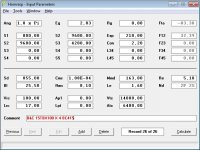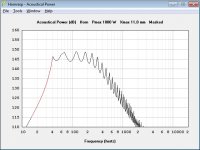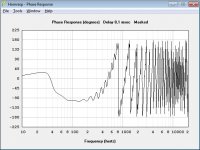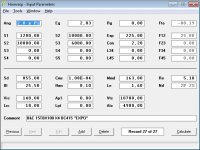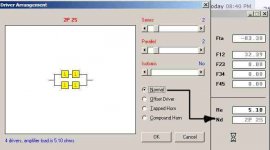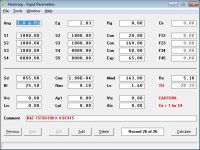
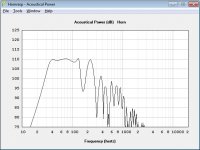
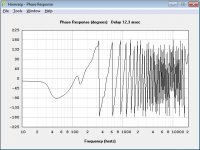

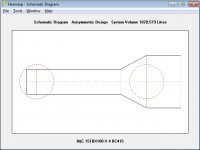
Here is the modified Tapped horn/bandpass hybrid.
The spl-respons looks more similar to the curves Danley presents in his PDF.
The phase-respons is a much more similar i think.
If one wants maximum spl one should use the radiation from both sides of the driver, like in a 6th order bandpass (potentialy louder then a 4th order with the same driver and power), or a tapped horn.
My strange hybrid has 1 - 2 dB more output, but i believe its actually more. Hornresp will not consider the losses in the back-chambers of the drivers, where the pressure will be very high with modern high power drivers like the B&C 15TBW100.
Cheers,
Johannes
Seriously impressive thinking here, and just to be clear, I don't know anything about the inner workings of Mr Danley's magnificent creations, in fact do any of us really know?
This might be something along the way of what he does, in principle, but we have no idea, therefore i put it to you that you have reached this conclusion on your own, you had no help, no sections or plans to model from, and yet you managed to think this up, and as I see it this is the closest approach published to date unless I have missed something.
Expanding on that I see it as you might have taken another step in efficiency here, perhaps a different one, and a very impressive one at that, introducing carefully balanced mass loading in two pipe segments like this.
You have every right to be proud of your findings, and until, if ever, Mr Danley let's us all know how he does what he does you have every right to claim these findings as your own, sure there are similarities in phase and response results, but I say it again - we do not know.
Thanks for sharing this, it benefits us all.
This might be something along the way of what he does, in principle, but we have no idea, therefore i put it to you that you have reached this conclusion on your own, you had no help, no sections or plans to model from, and yet you managed to think this up, and as I see it this is the closest approach published to date unless I have missed something.
Expanding on that I see it as you might have taken another step in efficiency here, perhaps a different one, and a very impressive one at that, introducing carefully balanced mass loading in two pipe segments like this.
You have every right to be proud of your findings, and until, if ever, Mr Danley let's us all know how he does what he does you have every right to claim these findings as your own, sure there are similarities in phase and response results, but I say it again - we do not know.
Thanks for sharing this, it benefits us all.
Hi Circlomanen,
For general comparison I like to use the 2pi environment, and 2.83 V (that's what DSL uses, only they measure @ 10m using 28.3V). The TH is quite a bit larger than the FLH. And, I agree w/ martinsson.
Regards,
For general comparison I like to use the 2pi environment, and 2.83 V (that's what DSL uses, only they measure @ 10m using 28.3V). The TH is quite a bit larger than the FLH. And, I agree w/ martinsson.
Regards,
Attachments
Last edited:
View attachment 445144
View attachment 445145
View attachment 445146
View attachment 445147
View attachment 445148
Here is the modified Tapped horn/bandpass hybrid.
The spl-respons looks more similar to the curves Danley presents in his PDF.
The phase-respons is a much more similar i think.
If one wants maximum spl one should use the radiation from both sides of the driver, like in a 6th order bandpass (potentialy louder then a 4th order with the same driver and power), or a tapped horn.
My strange hybrid has 1 - 2 dB more output, but i believe its actually more. Hornresp will not consider the losses in the back-chambers of the drivers, where the pressure will be very high with modern high power drivers like the B&C 15TBW100.
Cheers,
Johannes
This is good but the Danley box does not have a TH arrangement visible from the mouth. Even if it was a TH, try folding what you have into a 30in x 30in x 24in box per quadrant.
Hi Circlomanen,
For general comparison I like to use the 2pi environment, and 2.83 V (that's what DSL uses, only they measure @ 10m using 28.3V). The TH is quite a bit larger than the FLH. And, I agree w/ martinsson.
Regards,
1070 liters x 4 quadrants is 150 cu ft. Danley's box is 50 cu ft total.
The BC416 is 60 x 60 x 26 inch. It is not very hard to squeeze my TH hybrid into a 60 x 60 x 26 inch box.
But i don't know if this is how it works. I am guessing, and based on my sims, i believe it is not a simple FLH. Of course i can be wrong. Either way i find my "method" to work, as i can get the same or slightly better simmed performance as a similar sized exponential horn with the same drivers.
I have never seen a BC412/415 in real life. All i have to look at is his PDF from DSL homepage.
Cheers,
Johannes
But i don't know if this is how it works. I am guessing, and based on my sims, i believe it is not a simple FLH. Of course i can be wrong. Either way i find my "method" to work, as i can get the same or slightly better simmed performance as a similar sized exponential horn with the same drivers.
I have never seen a BC412/415 in real life. All i have to look at is his PDF from DSL homepage.
Cheers,
Johannes
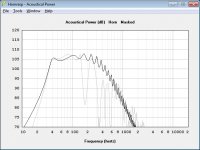
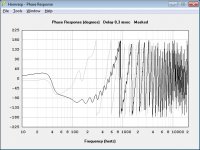
I am not very good at simming Exponetial massloaded bashorns.
I saw there was some things i could improve in my previous expo-horn.
I made the horn both a little longer and added some much needed area to the mouth. It is now 1102 liters compared to the TH-BP 1256 liters. Both of them well within the 15,24 x 15,24 x 6,6 = 1532,9 liters of Danleys BC415.
Above you see phase and spl-respons for them both. Please compare with his design.
Cheers,
Johannes
The hump at about 133 Hz in the phase-respons is very obvious in Danleys BC415. It might be ther for some other reason. He might use some kind of helmholtz-resonators for shaping the spl-respons, attenuate some peak or whatever. I have no way of knowing where it comes from.
All i see is that both my phase and spl-respons is more similar to his, then the exponential massloaded horn.
Cheers,
Johannes
All i see is that both my phase and spl-respons is more similar to his, then the exponential massloaded horn.
Cheers,
Johannes
My sketch in #13 of the 60 x 60 inch cabinet yields a path length of about 70" to the center of the horn exit, 1/4 wave of that puts tuning about 48.7 Hz.A quick estimate of the path length using this fold scheme yields a 2.08m distance which is only good for 80Hz. I think there needs to be more folds to it because the response curve has a knee at 36Hz.
Adding the length from the horn exit to the edge of the 60" x 60" frontal Boundary Control area, the last portion of the horn, the path length is about 99", a 1/4 wave length of 34.45 Hz- close enough to 36 Hz for rock and roll and the back of an envelope sketch 😉.
Art
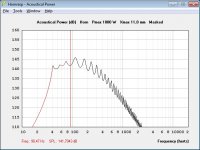
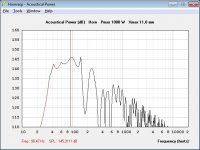
Everybody who heard them has commented on the "kick" and "punch", making musik really come alive.
Even though this is my very simple guesstimate simms, and very far fram Danleys magic, it is easy to see that the TH-BP has 3 - 4 dB more output in the very imporatant area around 80 - 100 Hz.
Cheers,
Johannes
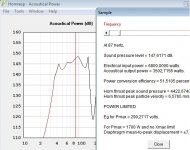
This is no proof in any way, but i got a surprise when i was looking at the max spl graph for my THBP with a more powerful BC 15SW115. I recognized the exact dB (147,617... rounding error from 148.) and frequency. I have not tried to get this exact max spl. I just swapped out the 15TBX100 for the 15SW115 and changed the length of the front resonator 2 cms. Then i wanted to see if max spl had changed...
Cheers,
Johannes
Last edited:
Hi X,
The Vint numbers from Hornresp are for the complete box w/ 4 drivers.
Regards,
Ok. I was thrown off because the SPL on Danley's box was 114dB at 2.83v and this one is 105dB - so I thought it was just one driver. I don't know how to read HR input screens to see that there are 4 drivers.
Hi X,
Just back from a birthday party. In the Driver Arrangement window you can set number and connection of drivers this is then reflected on the Input window right below the Re. In the lower left hand corner of the Driver Arrangement window you can also see the driver number, and the applicable load (note that this only reflects the Re).
Regards,
Just back from a birthday party. In the Driver Arrangement window you can set number and connection of drivers this is then reflected on the Input window right below the Re. In the lower left hand corner of the Driver Arrangement window you can also see the driver number, and the applicable load (note that this only reflects the Re).
Regards,
Attachments
My sketch in #13 of the 60 x 60 inch cabinet yields a path length of about 70" to the center of the horn exit, 1/4 wave of that puts tuning about 48.7 Hz.
Adding the length from the horn exit to the edge of the 60" x 60" frontal Boundary Control area, the last portion of the horn, the path length is about 99", a 1/4 wave length of 34.45 Hz- close enough to 36 Hz for rock and roll and the back of an envelope sketch 😉.
Art
I think you are right - the total double ended length threw me off as I was using the half wave freq not quarter wave.
Does setting 4 drivers automatically scale the system to 4 horns with dimensions shown or is it assumed all 4 horns are at the single driver location? Clearly that is not the same as 4 drivers, one at each quadrant of this box. I guess I don't know how to model a four chamber four path horn in HR.Hi X,
Just back from a birthday party. In the Driver Arrangement window you can set number and connection of drivers this is then reflected on the Input window right below the Re. In the lower left hand corner of the Driver Arrangement window you can also see the driver number, and the applicable load (note that this only reflects the Re).
Regards,
- Home
- Loudspeakers
- Subwoofers
- Danley BC-subs reverse engineered
